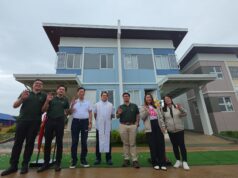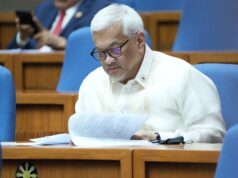CDC President and CEO Remollo (seated, 2nd right) and Cebu Pacific Air President and CEO Gokongwei shake hands after signing a lease agreement for the establishment of an aviation training center for airlines in the Asia Pacific region inside the Clark Freeport in Pampanga.
Joining them are (from left, standing) CEB Director for Legal Affairs Anne P. Tieng, CEB Director for Finance Trina Asuncion, CEB Chief Financial Officer Jaime Cabangis, CDC Directors Aro Mendoza, Manolo Feliciano, and Frankie Villanueva. (from left, seated) CEB Senior Vice President and Chief Strategist Bach Johann Sebastian and CDC Executive Vice President Philip JB Panlilio.
Photo courtesy of CDC PRD
CLARK FREEPORT – Citing estimates that the Asia region would need at least 72,000 pilots in the next 20 years, Cebu Air Inc. (CAI) president and chief executive officer Lance Gokongwei signed here the other day with the Clark Development Corp. (CDC) an agreement for the establishment of a world-class, $50-million pilot training academy.
“The future of aviation is in Asia. We expect a 35 percent of aviation future growth in Asia so there will be a great demand for pilots,” said Gokongwei after signing the agreement with CDC president and chief executive officer Felipe Remollo.
Gokongwei cited estimates that the volume of aircraft in Asia would increase by another 6,000 in the next two decades. “With each aircraft needing six pilots and another six co-pilots, that would translate to about 72,000 that need to be trained,” he said.
The aviation academy here would be built with the support of Montreal, Canada-based CAE Inc., a leading provider of simulation technologies, modelling technologies and integrated training services to airlines, aircraft manufacturers, and defense customers worldwide.
It has manufacturing operations and training facilities in 20 countries on five continents. It was founded in 1947.
“It will be a full aviation academy. We will break ground immediately so that we can start construction by August and be operational by September,” Gokongwei said.
He said that the academy will initially have two simulators, but this would be increased to four. Simulators are replicas of the cabins of aircraft together with all the gadgets and other equipment that imitate real aircraft when flown.
Gokongwei said his company chose Clark to be the venue for the academy “because we expect Clark to eventually be the country’s main international gateway.”
“It will be a major hub for all aviation related industries,” he said, pointing out that the academy would be the second investment of his firm at Clark, next to a hangar venture it established together with Singapore airlines.
Gokongwei also cited confidence in the leadership of CDC, the state-owned corporation that operates this freeport. He noted that negotiations for the academy were immediately facilitated by CDC officials whom he lauded “for efficiency and transparency.”
He stressed that the academy would be “a major training hub” for the Asian region and will also be open for the training of aviation engineers and cabin crew members.
For his part, Remollo said that “I am confident that the establishment of the academy will lead to an avalanche of other investments into Clark.”
“You did not commit a mistake in bringing your investments here,” he told Gokongwei, as he reiterated his projections that Clark could be “another Singapore” in the next five to six years.
“Geographically, Clark with 33,000 hectares is already bigger than Singapore which covers only about 6,500 hectares,” he noted.




